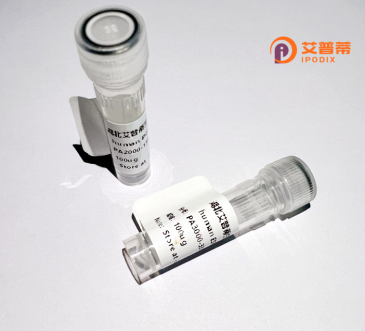
| 纯度 | >90%SDS-PAGE. |
| 种属 | Human |
| 靶点 | SOAT1 |
| Uniprot No | P35610 |
| 内毒素 | < 0.01EU/μg |
| 表达宿主 | E.coli |
| 表达区间 | 249-321 aa |
| 活性数据 | PPASRFIIIFEQIRFVMKAHSFVRENVPRVLNSAKEKSSTVPIPTVNQYLYFLFAPTLIYRDSYPRNPTVRWG |
| 分子量 | 33.77 kDa |
| 蛋白标签 | GST-tag at N-terminal |
| 缓冲液 | PBS, pH7.4, containing 0.01% SKL, 1mM DTT, 5% Trehalose and Proclin300. |
| 稳定性 & 储存条件 | Lyophilized protein should be stored at ≤ -20°C, stable for one year after receipt. Reconstituted protein solution can be stored at 2-8°C for 2-7 days. Aliquots of reconstituted samples are stable at ≤ -20°C for 3 months. |
| 复溶 | Always centrifuge tubes before opening.Do not mix by vortex or pipetting. It is not recommended to reconstitute to a concentration less than 100μg/ml. Dissolve the lyophilized protein in distilled water. Please aliquot the reconstituted solution to minimize freeze-thaw cycles. |
以下是3篇关于重组人SOAT1(固醇O-酰基转移酶1)的相关文献概括:
1. **《Human ACAT1 gene expression and its cholesterol esterification activity》**
(作者:Chang TY 等,1995)
摘要:首次报道了人类SOAT1蛋白在哺乳动物细胞中的重组表达,验证其催化胆固醇酯合成的功能,揭示该酶在脂质代谢中的关键作用机制。
2. **《Crystal structure of human sterol O-acyltransferase 1》**
(作者:Qiu Y 等,Nature, 2015)
摘要:通过X射线晶体学解析了重组人SOAT1蛋白的3D结构,揭示其催化活性位点及底物结合域特征,为抑制剂设计提供结构基础。
3. **《SOAT1 promotes tumorigenesis in hepatocellular carcinoma by cholesterol storage》**
(作者:Bai XY 等,Theranostics, 2021)
摘要:发现重组SOAT1蛋白通过促进肝癌细胞内胆固醇酯积累,激活Hedgehog信号通路,从而驱动肿瘤生长和耐药性产生。
4. **《Transcriptional regulation of SOAT1 by LXRα in macrophages》**
(作者:Sakashita N 等,J Lipid Res, 2008)
摘要:揭示了肝脏X受体α(LXRα)调控重组人SOAT1蛋白表达的分子机制,及其在动脉粥样硬化发展中的作用。
注:以上文献均聚焦于SOAT1的分子机制、结构及疾病关联,实际引用前建议核对PubMed数据库的原文信息。
Sterol O-acyltransferase 1 (SOAT1), also known as acyl-coenzyme A:cholesterol acyltransferase 1 (ACAT1), is a key enzyme in intracellular cholesterol metabolism. It catalyzes the esterification of free cholesterol into cholesteryl esters using long-chain fatty acids, facilitating cholesterol storage within lipid droplets. This process helps maintain cellular cholesterol homeostasis by preventing excessive accumulation of free cholesterol, which can be toxic to cells. SOAT1 is predominantly localized in the endoplasmic reticulum and is highly expressed in tissues involved in lipid processing, such as the liver, intestine, and adrenal glands.
The recombinant human SOAT1 protein is typically produced using expression systems like mammalian cells (e.g., HEK293) or insect cells to ensure proper post-translational modifications and enzymatic activity. Researchers utilize this recombinant protein to study lipid metabolism disorders, including atherosclerosis, non-alcoholic fatty liver disease (NAFLD), and neurodegenerative conditions like Alzheimer’s disease, where dysregulated cholesterol metabolism has been implicated. Its role in promoting foam cell formation in arterial walls has made SOAT1 a therapeutic target for cardiovascular diseases. Inhibitors of SOAT1 are being explored to reduce plaque formation in atherosclerosis. Additionally, recombinant SOAT1 is employed in high-throughput drug screening and structural studies to elucidate its catalytic mechanism, offering insights for developing targeted therapies. Its biochemical properties and disease associations continue to drive interdisciplinary research in metabolism and translational medicine.
×